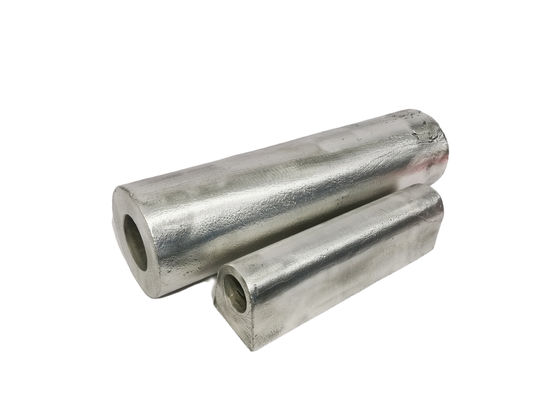-
Magnesium Sacrificial Anodes
-
Magnesium Anodes Cathodic Protection
-
High Potential Magnesium Anode
-
Magnesium Ribbon Anode
-
Extruded Magnesium Anodes
-
Prepackaged Magnesium Anode
-
Water Heater Magnesium Anode
-
Wrought Magnesium Alloy
-
Magnesium Alloy Bar
-
High Strength Magnesium Alloy
-
Magnesium Alloy Sheet
-
Dissolvable Magnesium Alloy
-
Magnesium Rare Earth Alloy
-
 FedererReliable quality of sacrificial magnesium anode.
FedererReliable quality of sacrificial magnesium anode. -
 AliceWell suited to our cathodic protection needs.
AliceWell suited to our cathodic protection needs.
17 Lb Magnesium Anode Galvanic Corrosion Sacrificial Mg 8000Ω
| Place of Origin | CHINA |
|---|---|
| Certification | USA: G97,ASTM |
| Minimum Order Quantity | 1000KGS |
| Price | Negotiable |
| Packaging Details | Pallet packing, or on customer's request |
| Delivery Time | 30 Days after receiving the deposit |
| Payment Terms | 50% Deposit , 50% Balance before deliver to the port |
| Supply Ability | 500 mts per month |

Contact me for free samples and coupons.
Whatsapp:0086 18588475571
Wechat: 0086 18588475571
Skype: sales10@aixton.com
If you have any concern, we provide 24-hour online help.
x| Keywords | High Potential Magnesium Anode | Shape | D Type |
|---|---|---|---|
| Type | High Potential | Application | Cathodic Protection |
| Adventage | Better Electrochemical Properties | Service | OEM / OEM |
| Technical Standard | GB/T 17731-2015 | Standard | High Quality |
| High Light | 17 Lb Magnesium Anode,Galvanic Corrosion Sacrificial Anode Mg,17 Lb Galvanic Corrosion Sacrificial Anode |
||
High Potential Magnesium Anode Used In Soils With Resistivity Greater Than 8000Ω
Introduction:
When metal structures are submerged or buried, oxidation can cause rusting, which is a chemical reaction of the metal with its surroundings. This reaction can lead to loss of metal and ultimately overall structural integrity over time, if left unaddressed, until the point of failure.
Sacrificial anodes (or primary cells) are the main component of current cathodic protection systems. These blocks, rods, plates, or extruded strips are made of metal alloys that are less voltage active than the structural alloys that need protection. In other words, the electron supply that facilitates the dissolution of the primary metal will be transferred or consumed by the "sacrificial" metal.
The potential of the high-potential magnesium anode is -1.75V CSE, and the driving voltage is 0.85V; the potential of the low-potential magnesium anode is -1.55V CSE, and the driving voltage is 0.7V. High potential sacrificial anodes are recommended in soils with a resistivity greater than 8000Ω.cm
Chemical composition %:
| Alloy |
Al |
Mn |
Si |
Cu |
Ni |
Fe |
Other impurity(each) |
Total Impurities |
| Mg-Mn | 0.01 | 0.50-1.30 | 0.05 | 0.005 | 0.001 | 0.03 | 0.05 | 0.30 |
The electrochemical performance of:
|
Open voltage |
Closed voltage |
Actual capacity |
Efficiency |
| 1.70-1.75 | 1.58-1.62 | 1230min | 50min |
Specification:
| Type | Weight(kg) | Width(mm) | Hight(mm) | Length(mm) | Insert |
| 9D2-1 | 4.1 | 63.5 | 63.5 | 669.9 | Strip |
| 9D2-2 | 4.1 | 69.9 | 76.2 | 560 | Strip |
| 14D2-1 | 6.35 | 63.5 | 63.5 | 1054 | Strip |
| 14D2-2 | 6.35 | 69.9 | 76.2 | 850.9 | Strip |
| 20D2-1 | 9.1 | 63.5 | 63.5 | 1505 | Strip |
| 20D2-2 | 9.1 | 69.9 | 76.2 | 1270 | Strip |
| 9D3 | 4.1 | 88.9 | 95.25 | 258.8 | Strip |
| 17D3 | 7.7 | 88.9 | 95.25 | 657.2 | Strip |
| 32D5 | 14.5 | 139.7 | 146.05 | 523.9 | Strip |
| 48D5 | 21.8 | 139.7 | 146.05 | 765.2 | Strip |
Features:
The main characteristics of high-potential magnesium alloy sacrificial anodes are large electricity per unit mass, high potential, small specific gravity, negative potential, high driving voltage to Fe, low current efficiency, etc., especially suitable for high resistivity media. When using magnesium alloy sacrificial anode, care should be taken to avoid collision with steel structure. American standard ASTM8431993 (2003) and Chinese standard GB/T177312004 both require the current efficiency of high-potential magnesium alloy sacrificial anodes to be higher than 50% and the potential higher than 1.77 V.
Application:
Applicable to anti-corrosion protection of the oil, gas, water supply, and drainage pipelines, as well as the protection of harbor, ship, reservoir, gate, and other projects in the water.
D type and R type photo:
![]()







